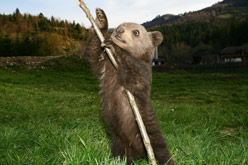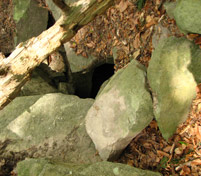 |
|||||||||||||||||||||||
|
|||||||||||||||||||||||
| First page | Financiers | Contact |

 |
 |
 |
 |
| Practices and demonstrative actions | ||
| - Methods of optimal assessments for brown bear population | ||
| - RAT : risk assessment team | ||
| - ARMU : animal rescue mobile unit | ||
| - Reducing of juvenile mortality and monitoring the active dens | ||
| - Systems for reducing damages produced by bears | ||
| - Analyze of the degradation | ||
The den’s disturbance by different human activities leads each year to drastic decreasing of the cub surviving rate, due female’s abandon. Often the 1-3 months old cubs are abandoned by the females, these being scared by wood harvester machines, in the neighborhood of the nourish den. The actual protected areas don’t cover entirely the hibernation areas and the forestry management can not restrict an area unless it is a proved hibernation site. Based on the Governmental Order no. 57/2007 it can be forbidden and approbate any human activity in areas with identified bear hibernation dens. The den’s identification and the informing of the forest’s administrators regarding their existence will insure an efficient protection during the born and nourish period of the cubs- January-April. |
 |
Identification and locating of bear dens will be made on the wildlife management areas at the entire project’s level. Using the information collected during the monitoring activities and the collected data from the local people and wildlife managers, it will be achieved a first map. The locations of the identified dens based on field observations and all the validated information with field verifications will be transferred in GIS system and will be the base of a final map. |
Monitoring of the active dens will be carried out during the whole hibernation season by installing of mini cameras and temperature - humidity sensors which will register permanently the desired parameters. The mini-cameras will be mounted in the dens before hibernation and the data will be gathered by connecting them to a portable computer, following to be identified the number of cubs and the family’s behavior under different meteorological factors. Each ear are going to be monitored at least 15 dens from the project’s area in different natural habitats. |
|
The den monitoring during the winter period will provide information about the hibernation duration, influences of the climate and meteorological changes, favorability indicators for the placement, etc. In order to evaluate the differences between some external factors, at CRCM Lepsa will be placed an automatic meteorological station. This will register the humidity, temperature, wind direction and intensity, atmosphere pressure at every 5 minutes. The comparing of the external data with the data obtained from the dens will permit identifying the “threshold” values type which determines different behavior changes of females during the winter period. |
 |